SS Numidia
The Steamship Numidia was brand new, launched 04th February in 1901 by D&W Henderson and Company of Glasgow (her port of registration), for the Anchor line. Owned and operated by a Mr William Meiklereid again of Glasgow, when she left Glasgow 28th Feb of that year, bound for Calcutta (modern day Kolkata, India) via Liverpool. Her maiden journey passed without incident, as far as there is no mention of anything unusual prior to her second sailing from Liverpool 06th July of 1901, where she had loaded a “general” cargo of 7000 tons bound again for Calcutta, under her Master, Captain John Craig
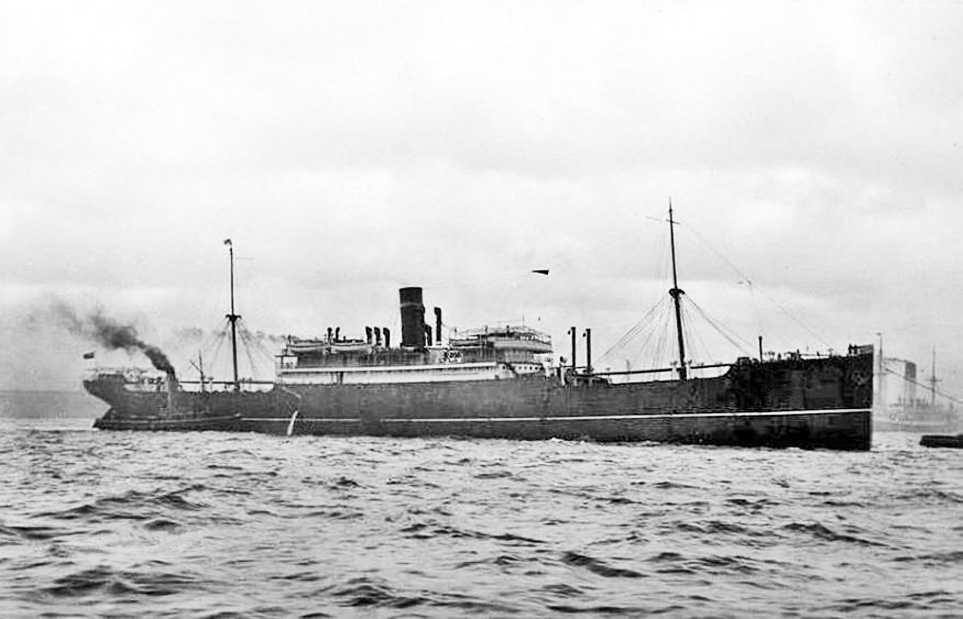
The Anchor Line had its beginnings in 1838, started by Nicol & Robert Handyside, Nicol was the Russian Consul, an official appointed by the government of a country to look after its commercial interests and the welfare of its citizens in another country, although the “interests” of Russia at that time, expressly in Glasgow, even in Scotland in general were lost to me… However, in the 1890’s Russia completed their Trans-Siberian Railway pushing East, and the British were expanding our large-scale commercial activities in China through Hong Kong, and the “treaty ports” of China. Russia very much desired an all season port south of Vladivostok, and both nations were fearful of Japanese plans of expansionism in the Far East (apparently more so than they were wary of each other), meaning both saw a benefit to mutual collaboration. It, therefore, is not as surprising as it might seem that Russia had a consular representative in Great Britain and, as Russia was also a customer for British Shipping, including Warships, perhaps that makes a case for a Russian consul in Glasgow…….. The Handyside brothers traded with Russia and the Baltic under charter arrangements and were merchant ship-brokers operating as N&R Handyside &Co (Jisc Archives Hub: “Records of Anchor Line, shipping company, Scotland. Administrative/Biographical History” Online resource: https://archiveshub.jisc.ac.uk/search/archives/93c7f198-d46d3c15a46ae692c2cfb038?terms= %22Anchor%20Line%20Ltd%20 (shipping%20company%20%3A%201852-%20%3A%20Scotland). Accessed 29/12/22)
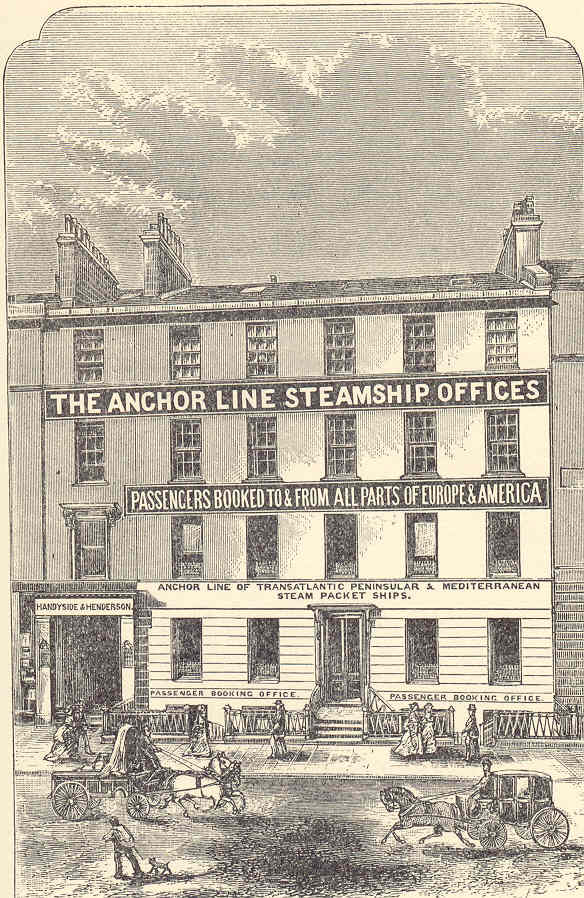
In 1852 Thomas Henderson, Master Mariner, joined the company having retired from the sea, but bringing with him a desire to run shipping to Canada & the USA. In 1854 the first of many vessels was bought and a year later, in 1855, Thomas became a full partner, the business changed its name to Handysides & Henderson, converted a former clipper to steam power, and, trading under the “Anchor Line” title, began running steam packets across the Atlantic to New York
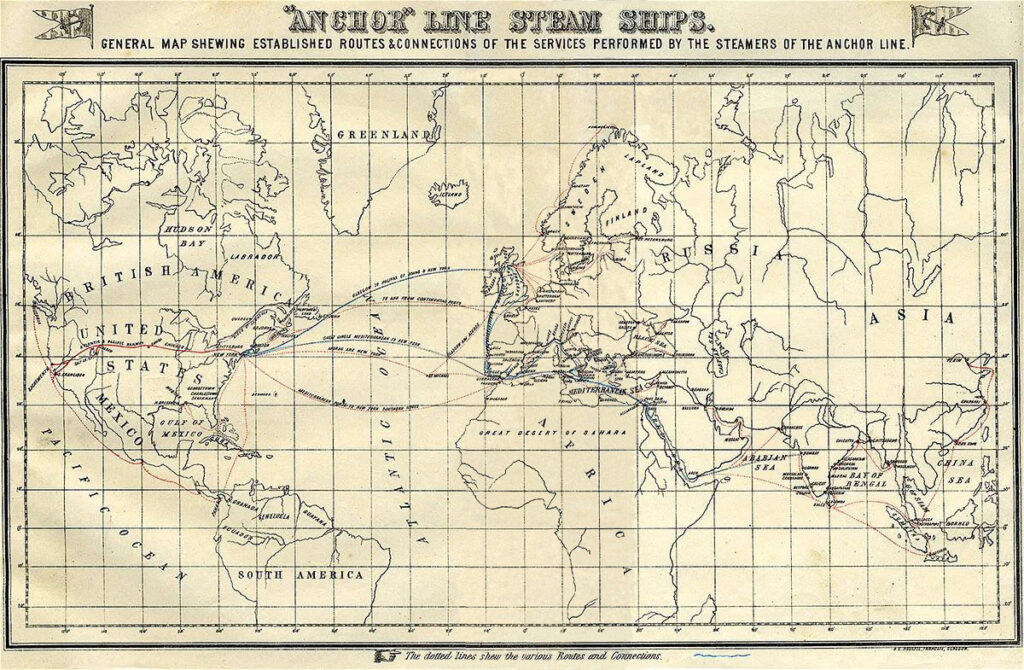
In 1857 two Anchor Line ships were chartered by the British Government to take troops to India to quell the Indian Mutiny, that year also saw Thomas’ two brothers begin the Finnieston Steamship Works Co primarily to construct steam engines (for conversions from sail to steam and for supply to other shipbuilders) but eventually becoming D&W Henderson c1858 and engaging in full ship builds of their own. In 1865 “Henderson Brothers” opened the Anchor Line Office in New York, followed by an office in Londonderry, Ireland, in 1869 which was quickly followed by offices in Liverpool & Dundee whilst services expanded to add Italy (Naples) to New York and increased to include India on the opening of the Suez Canal, which was heralded by an Anchor line vessel, the SS Dido, becoming the first vessel to pass through the canal February 17th 1867, although it would not “officially” open until November of 1869
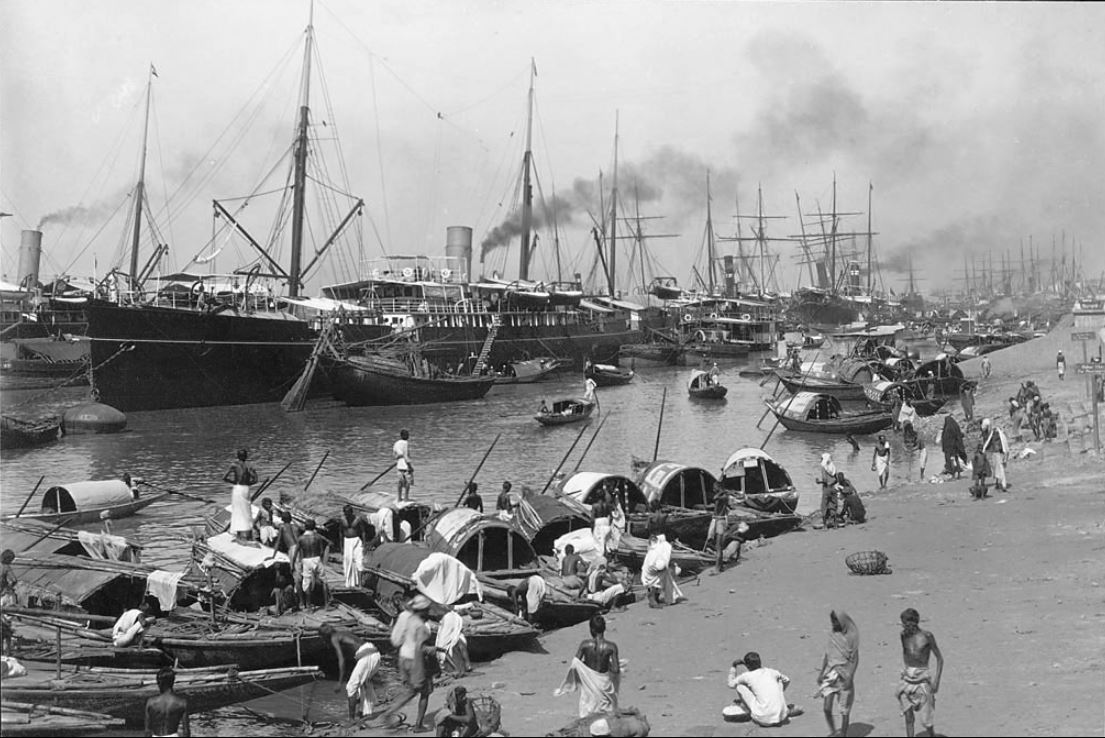
In 1690 The Honourable East India Company (EIC) had established a trade post in what was “Kalikata” under the Mughal Emperor Akbar (until 1605), Job Charnock of the EIC had attempted to establish trade at the Hooghly river but had not managed a sufficiently equitable relationship with the local officials there, and had moved on to what was then named Kolkata, and became, in English, Calcutta from that point. (Britannica: “History of Kolkata, the early period” https://www.britannica.com/place/Kolkata/History Accessed: 30/12/2022) The Hooghly river was both wide and deep at Calcutta making it a natural choice for a port of sorts, although there were marshes and swamps near, there were local Indian merchants who had moved down from the rivers increasingly silted upper reaches, so commerce was practical and there was clearly a market for trade in both directions, into and out of the Indian continent
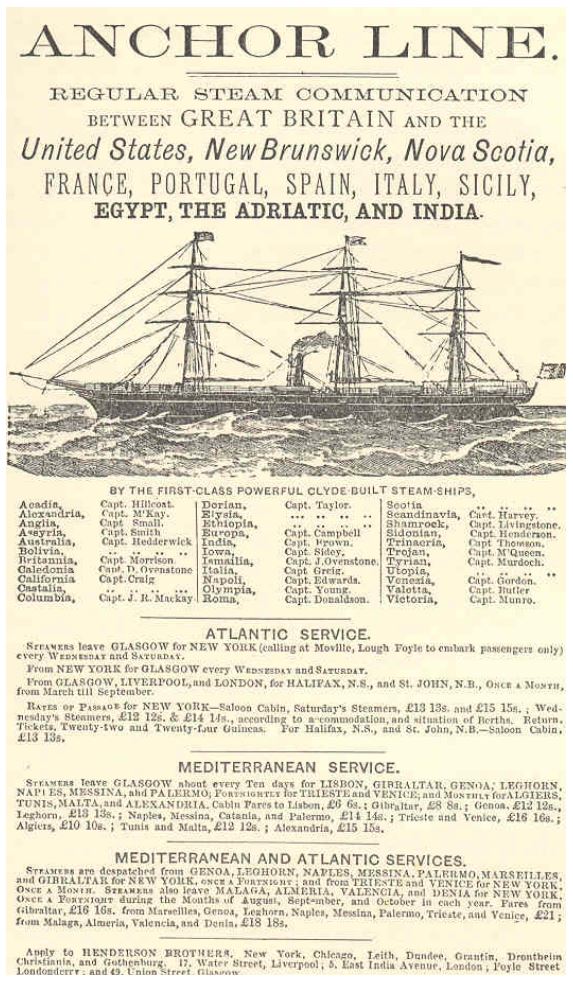
There were various resistances to trade and “Empire” with notable sackings of the town in 1756 by Siraj al-Dawlah, which saw British prisoners interred in what would become known as “The Black Hole of Calcutta”, with many deaths attributed to the heat and appalling conditions. Robert “Clive of India” Clive re-took the town defeating al-Dawlah in June of 1757, building Fort William to consolidate the British presence there. The continued military presence and the increasing wealth of the town saw it become the British Capital of India in 1772, drainage reduced the swamps and correspondingly the outbreaks of Malaria, this had the additional effect of increasing the density of population, and the quality of the “palatial” residences being built by the wealthy local merchants
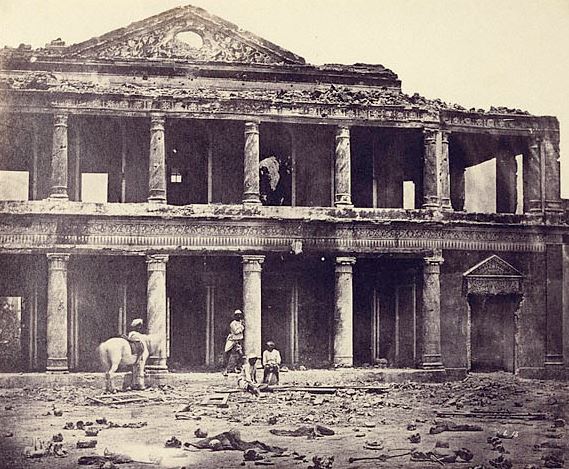
Calcutta’s influence spread throughout India and with the coming of the railways in 1854 Calcutta connected its trade to Peshawar, now part of Pakistan. This British influence in India, and the imposition of British officials had become an irritation to the Indian aristocracy and the Indian Brahmans, Priests who maintained themselves as highest of what was and still largely is a “Caste” or status divided secularity (where “untouchables” are the lowest “class” then workers, then traders, then warriors and at the upper level the Aristocrats & Brahmins……), this lead to inevitable discontent, which erupted in a rebellion, beginning amongst the locally employed East India “Sepoy” Troops spreading from Meerut through Delhi, Agra, Kanpur and Lucknow and was called by the Indians the “First War of Independence”. The British would not cede India and the Anchor Line was amongst several shipping companies to supply troops and much needed supplies to besieged British Troops, and some loyal Sepoy throughout India, resulting in bloody battles with massacres committed by both Indian and British troops. Following protracted sieges, notably at Delhi and Lucknow, and vicious sporadic fighting, the British quelled the uprising and eventually re-established complete control in July of 1859
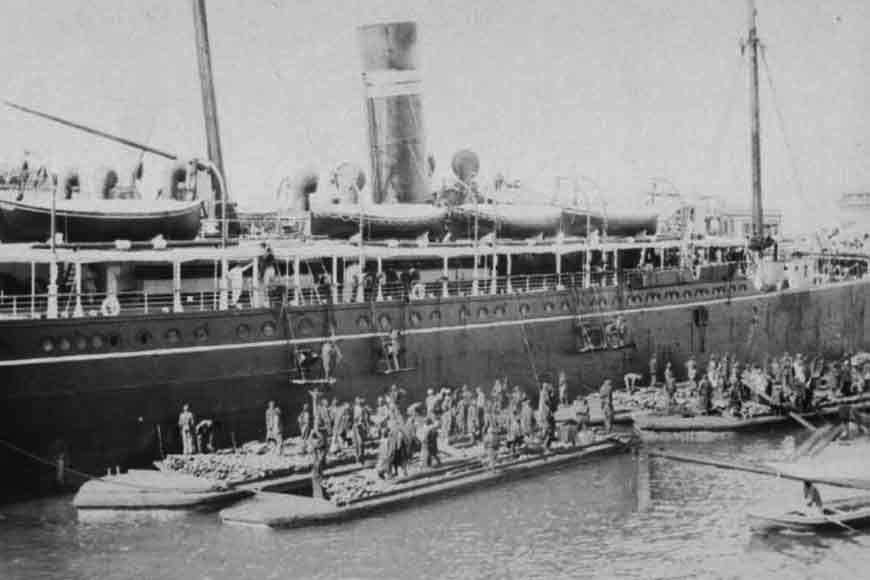
With their connection to India already made supporting the re-supply during the Indian Mutiny of 1857, continued trade to India and the carriage of those trading there to and fro, meant the Anchor line had a regular scheduled departure from Glasgow, calling at Liverpool and then sailing to Calcutta via the Suez Canal. Three of the Anchor line ships had been specifically built to undertake this trade route, the Assyria built 1900, yard number 418, The SS Numidia built 1901, yard number 419, and the Circassia built 1902, yard number 431. Numidia was built as a steam cargo ship of 6,399 GRT by D. & W. Henderson & Co., Ltd.at Meadowside Shipyard (85 Castlebank Street, Glasgow, Scotland), for the Anchor Line Ltd. She was launched and delivered on 04 February 1901 and her propulsion was provided by a triple-expansion steam engine through a single prop-shaft giving her a top speed of 12 knots. For those of you immersed in technical details here is the specification for the Numidia
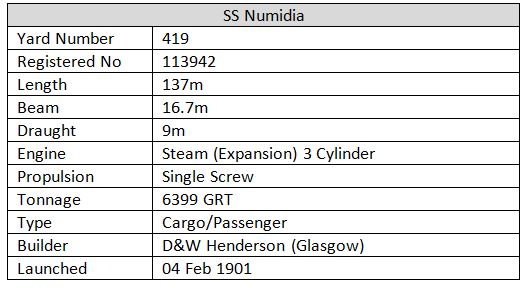
Perhaps the only chance we will get to look at the Numidia is to look at her sistership Circassia II, the sad loss of Numidia on the Brother Islands on what was her second journey, means to date there are no photographs I’ve been able to find anywhere, and I include in that search R. S. McLellan’s “Anchor Line 1856 – 1956” a detailed history reference which has many of the line’s ships represented, but sadly not Numidia. I truly hope one will emerge but to this day not even the Anchor Line archives at Liverpool have yielded one. I will continue to look and if I find one I will add it to the piece, for now, Circassia II, Numidia’s sistership, shown below, is the nearest direct comparison we have and, as she was constructed in 1902 off the same plans, we can be sure Numidia looked pretty much identical, those photos and pictures you see on articles and wreck pieces similar to this one, claiming to be Numidia, are invariably incorrectly attributed, often to the “Numidian”
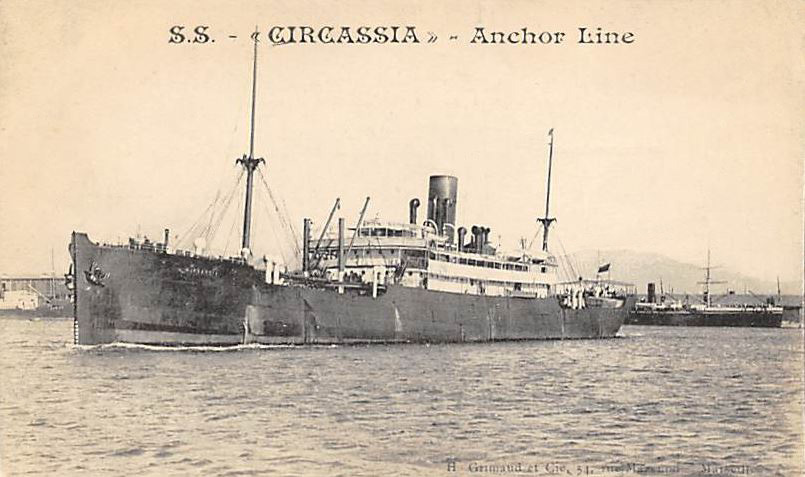
Numidia had a particularly striking stern, Victorian steamships had developed from the sleek sailing ships and clippers, some still operating well after steam power proved more reliable and generally (with distinct exceptions) faster than the best of the clippers. With the opening of the Suez Canal the few clippers still trading were generally on the Australian routes, where the wind could be relied on to make them competitive against the coal fuelled steamers. The residual full rig sailing masts & sails remaining on early steamships displayed the lack of trust in steam in the early days, on occasion they proved their worth too, when steam powered ships had failures at sea and limped back on sail power. But the other remainder of the sail era prominent on the early steam vessels was the overhanging, rounded stern, a beautifully stylised feature that persisted long after the sails and masts had gone for ever. Numidia had a particular stern, she featured a deeply curved stern hull transition down to the main deck which can be seen in the main Circassian photo at the opening of this piece, just behind the funnel of her tug at the stern on her starboard side, the cut features on the for’ard deck transitions from quarterdeck to main and again from main to forecastle
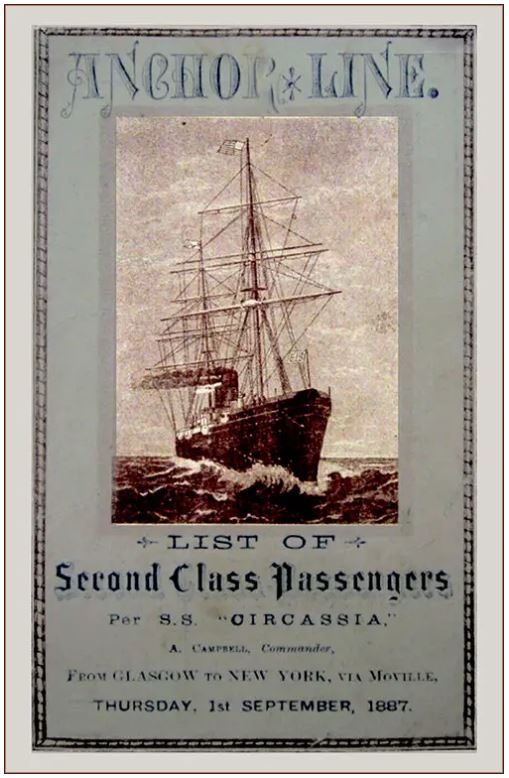
The brand new Numidia set sail on her maiden voyage on the 28th February 1901 departing from Glasgow, she was captained by John Craig and bound for Calcutta, it seems this was an entirely successful voyage which saw her back safe in Liverpool re-victualling and loading for a departure on the 06 July 1901. Numidia was carrying 7000 Tons of “general cargo” and casting off with a crew of 97. Numidia successfully transited the Suez Canal via Port Said exiting from Port Tewfik, the city of Suez, early on 19 July and continued south into the Red Sea. Numidia passed the island of Shadwan at 1900 that evening. Captain Craig, altered course at 2300 and two hours later, at 0100 in the dark morning hours of the 20th the Big Brothers Island Light was sighted off of the port bow. John Craig altered the ship’s course again intending to pass a mile to the west of Big Brothers
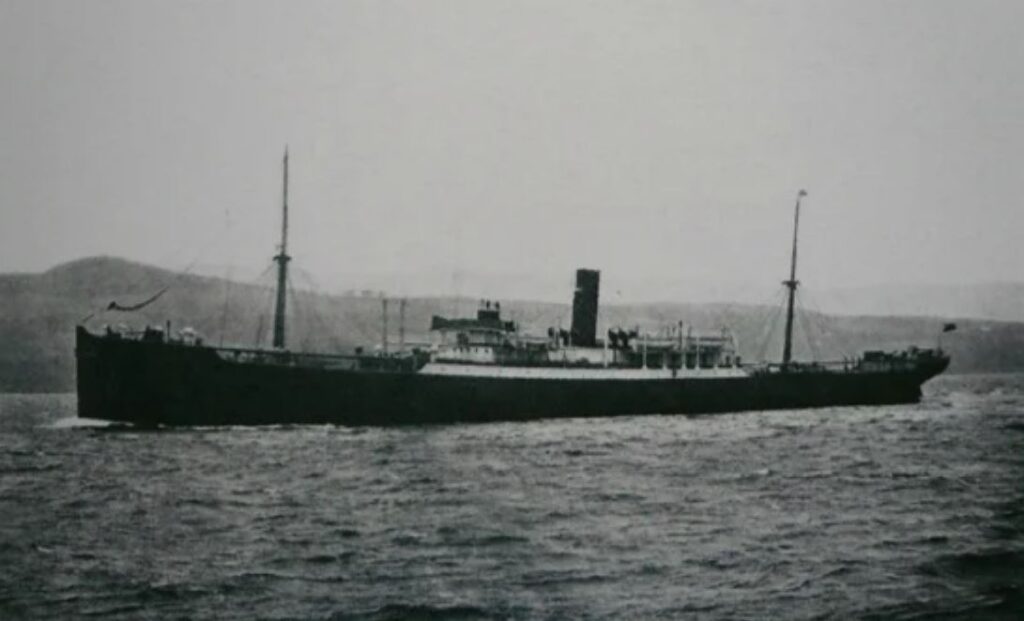
Captain Craig, clearly happy with the Numidia’s progress and position, left the Bridge in the hands of the Officer of the Watch with the instruction that he be notified when the Big Brothers light was abeam of the ship. It is not clear exactly why Captain Craig was not woken, the belief at the enquiry into Numidia’s loss was that the Watch Officer had fallen asleep, but at 0210 the sound of Numidia running aground on the northern plateau of Big Brothers in clear view of the lighthouse rent the night! Captain Craig, on reaching the Bridge, tried in vain to get Numidia off the reef by reversing her, after almost two hours she was still firm on the rocks, Numidia’s bow had sustained serious damage and she was taking on water, realising the futility of the situation Captain Craig ordered the engines stopped
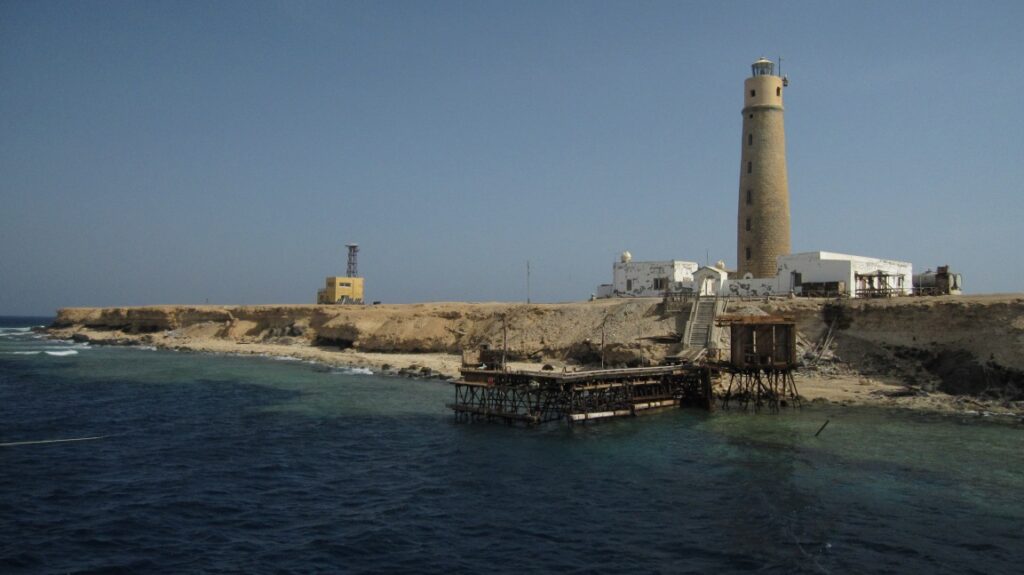
It didn’t take Captain Craig long to realise the bow damage had doomed Numidia, despite assistance from ships including the SS Rhipens, which came into view at around 07:40 on the 20th July only hours after Numidia hit the rocks, and then took despatches from Numidia to Suez calling for assistance. All following attempts to get Numidia off the reef were unsuccessful, the bow was too damaged and the water in her bow was helping to pin her to the rocks, all that remained was for Captain Craig to give the abandon ship order and permit the crew to be rescued and taken back to Suez. Captain Craig remained with his ship for seven weeks after the grounding supervising the removal of Mail and cargo and no doubt ensuring the same was not looted from the site by local boatmen and tribesmen, as was often the case in the remoter of regions of the Red Sea at the time. Numidia inevitably broke her back on the reef, separating just for’ard of her bridge, although tides are minimal in the area, there is a range of a metre or so and there can be quite fierce seas on occasion too. The loss of Numidia would be laid at the feet of the Officer of the watch who the Board of Trade enquiry believed fell asleep, failing to navigate the Brothers Island leading to the vessel striking the reef, it would cost him his ticket for 9 months, although I do not know his details and cannot say if he sailed again after Numidia’s loss
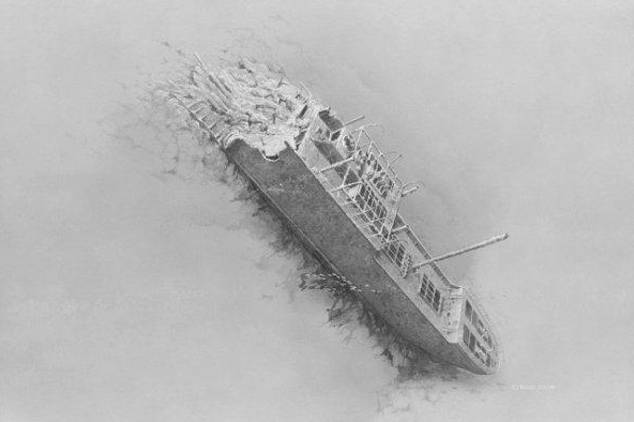
The steep angle of the reef and the stresses of tide and sea state left the bow of Numidia in the shallows and the main part of the wreck upright but lying down the reef to its base, her stern and prop at around 80m, over the years she has become a part of the reef, especially midships where the upper length of her hull has collapsed into it and her bridge area is just ruined and indistinguishable metal and coral. I first dived Numidia on my fourth Red Sea trip, we were diving off the MV Hurricane (a great Liveaboard that burned out with tragic the loss of 3 British divers in June of 2023), this was the first “Southern Red Sea” expedition and a new area to me entirely, my Green Navy Log records: “28/04/10 BIG BROTHER ISLAND “Numidia” This is an awesome wreck and actually is defying gravity as she is almost vertical on the reef. One good storm and she looks as though she would disappear! We dropped down the Port side to 50m at the stern mast which is still upright in and around the lower deck which is easily accessible as the wood is all gone. Again there is a classic engine room air intake in the hull but more broken. Up along the prop shaft tunnel and into the broken through centre section, this is heavily rotted but navigable with caution. Out onto the deck area round the mid ships block house & then through into the centre section to come out of the between decks to decompress again on the reef where we saw two turtles and a conger – sorry spotted Moray ell to be accurate! Plenty of Pipe Fish & Big Eye Jacks and shoals of Anthea along with beautiful hard & soft corals – amazing dive! Buddy Craig & Gaz & Claire Air In 200 Out 100”
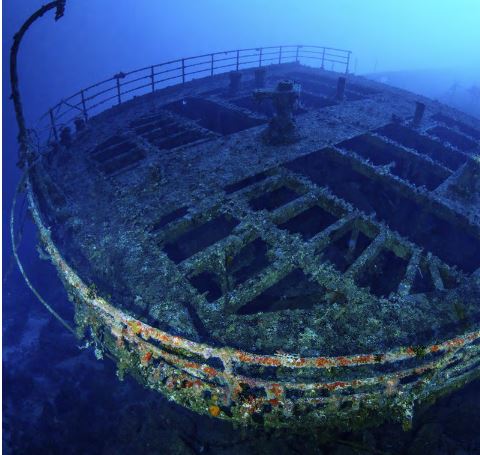
My next dive on Numidia would be just a year later, clearly the Southern Red Sea Wrecks had impressed me and another entry in the Green Navy Log records: “02/08/11 Red Sea “Numidia” Big Brother, dropped in & down the side to 40m & up through the port companionway, half way up we dropped starboard into the engine room to exit the bridge which is broken open. Back in through the Starboard Bridge area and down & through the bridge area coming out at the rear of where the funnel would be – in and through again and out the Port side to see the whole hull going into the deep – wonderfull! There were too many fish & corals to mention but two Napoleon Wrasse got close & a 3’ Barracuda being cleaned on the reef by a tiny & brave blue cleaner Wrasse – a magnificent dive Viz 30m Air In 210 Out 150 Buddy Craig 28%”
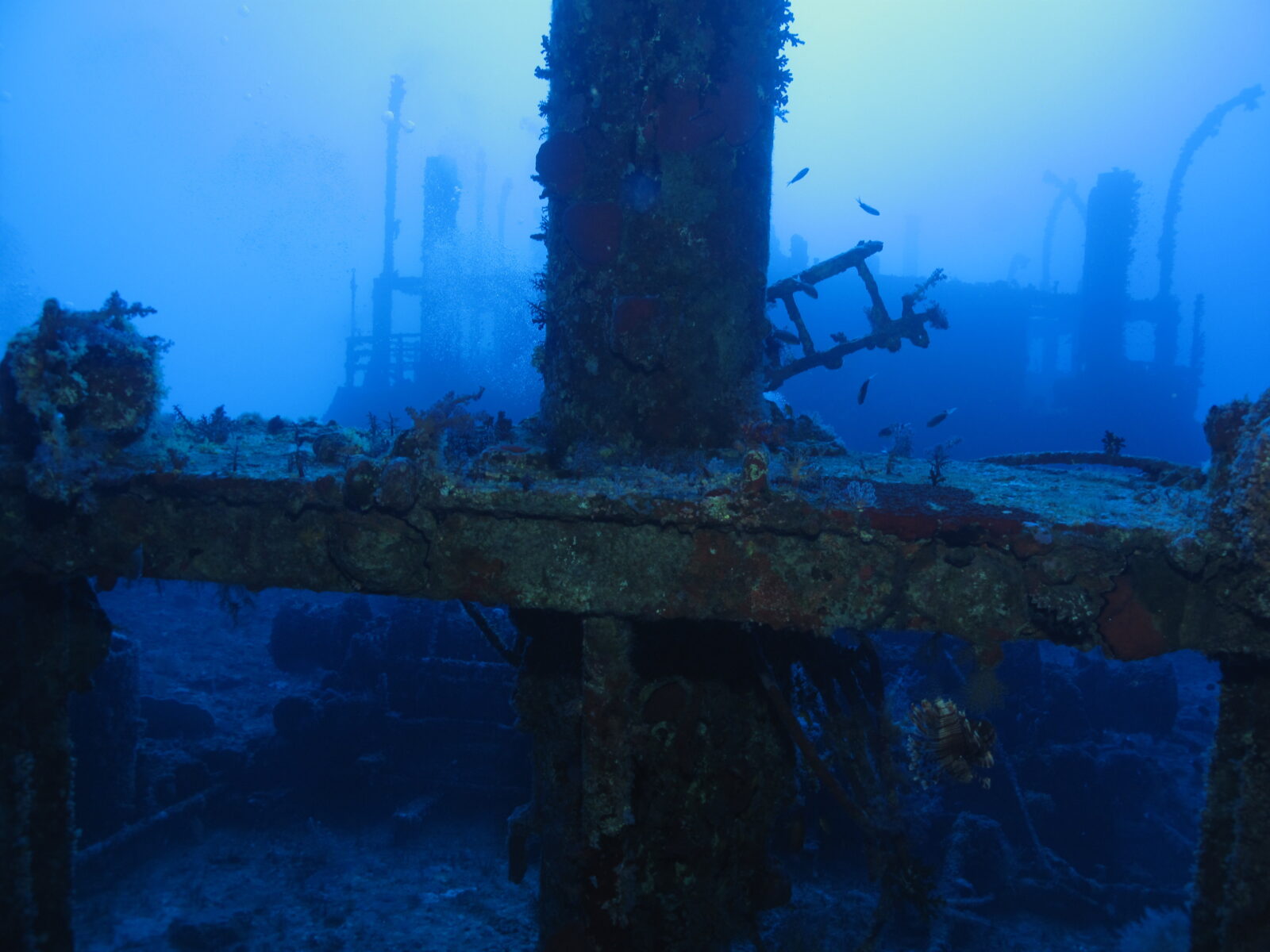
I was lucky enough to get back to the Red Sea in 2013 and again we were on a wreck safari including the Southern wrecks, this time there was quite a current as you will see “28/07/13 NUMIDIA – RED SEA _ Brothers A maul to get down to her in a very fast current (4kt ish) but wonderful to rest at the hatch combing looking at the stern rail & bollards. Into the hull for a circuit through the hold winding through the collapsed decking & bulkheads – engine room & to the break at the for’ard bridge area. Round the hull and on to the reef to deco and watch her disappear from view. A fantastic dive Air In 200 Out 100 Buddy Craig”
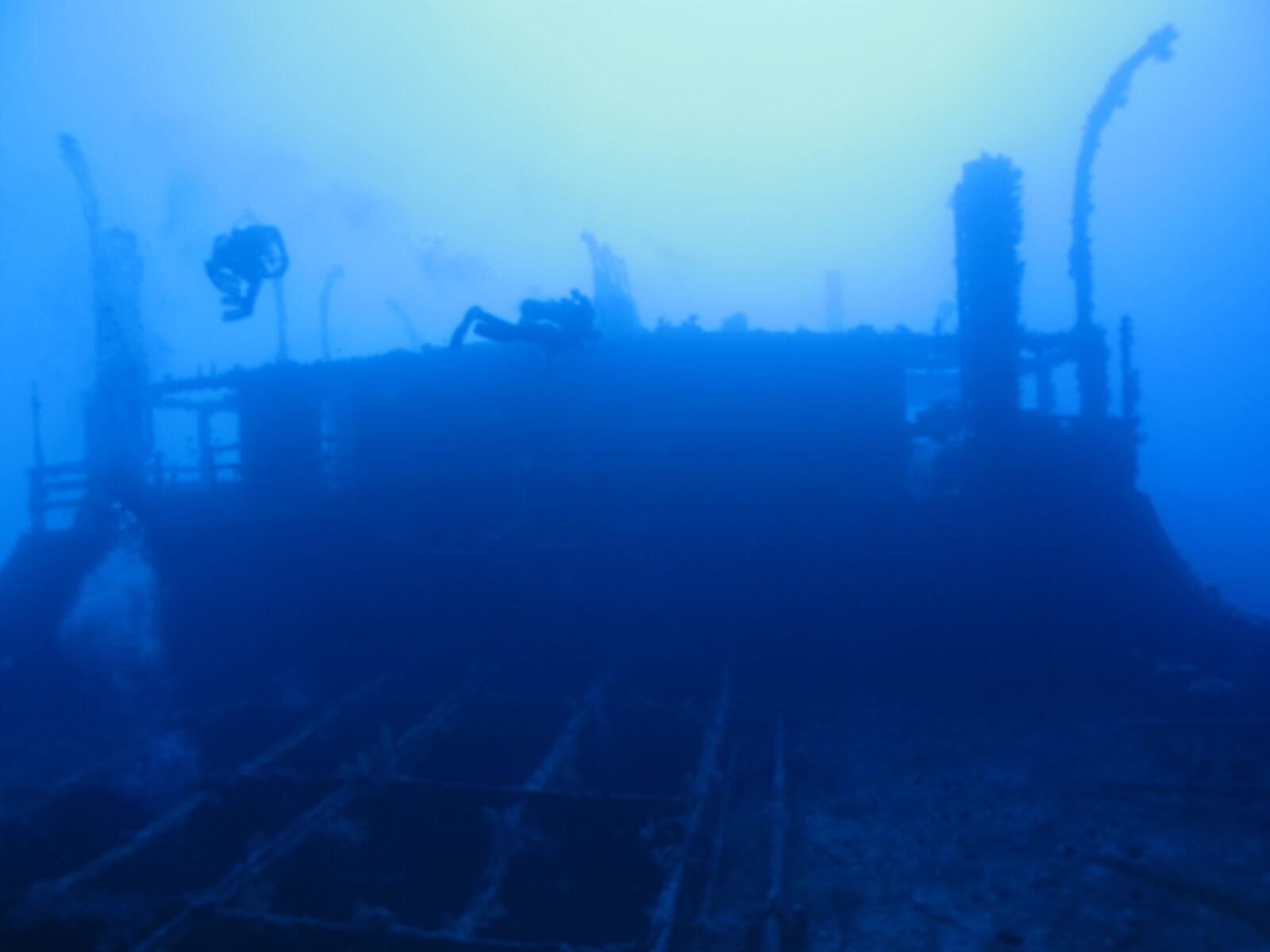
I have often heard divers extol reef diving over wreck diving, I have never really understood that perspective, I love the colours and diversity of a reef as much as anyone, however every wreck acts as an artificial reef anyhow, the first minute or so a ship goes down fish and marine life are drawn to it. I have dived in some barren locations where the only thing there is a wreck, and usually, as a result it is teeming with life, fish of all sizes, crustaceans, eels, soft and hard coral and that’s not just in warm seas, anyone who has dived the James Egan Layne will attest to the fields of dead man’s fingers down her sides and the shoals of Bib & Pouting swimming through her
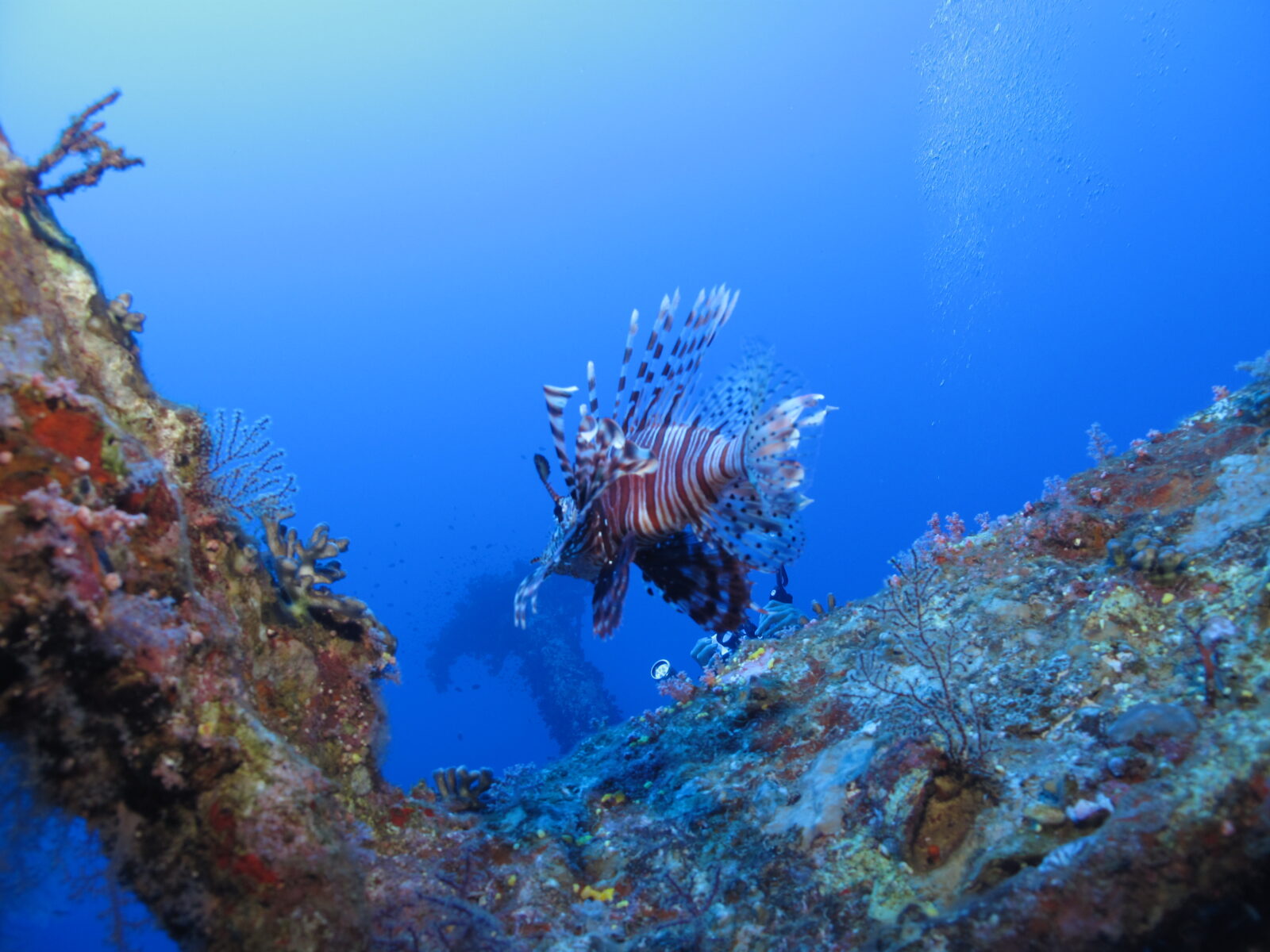
Numidia is a very good case in point, her hull settled on a reef, undoubtedly there were corals and marine organisms already, but those have now colonised Numidia too, and what’s more Numidia has history, a connection to distant pasts and many lives even after only two brief voyages, you don’t generally get that from an isolated Atoll or a rock outcrop or a barren sea-bed, unless of course some poor unfortunate vessel happens to land on them…….and when you’ve finished your exploration of as much of the wreck as you can, then there is decompression……..that’s what reefs are for!
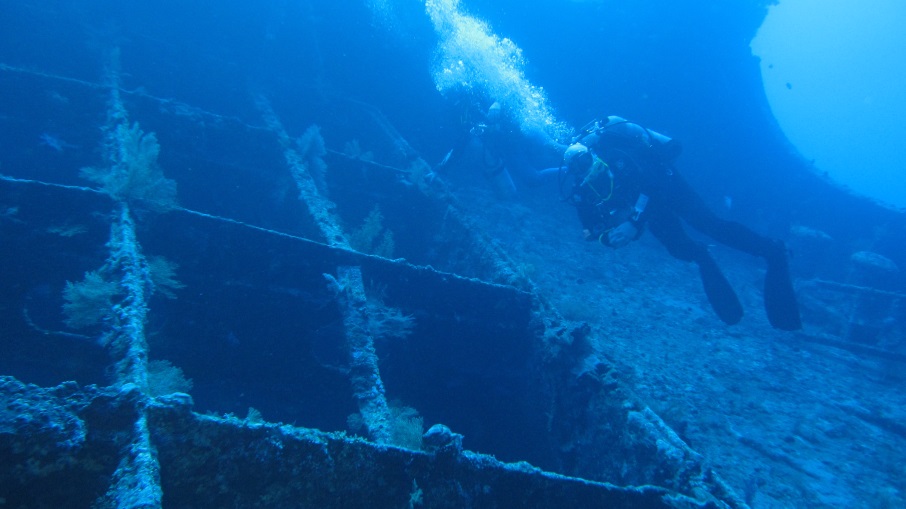
The Anchor Line was another of those Liverpool Shipping Lines that made the city the hub of Britain’s international trade, for the most part far more trade passed through Liverpool than did London, the Anchor Line was a piece of Liverpool’s history, although began in Glasgow around 1854 with the Handyside Brother’s outright ownership of their first vessel “Phantom”, Following the docking of “Tempest” out of Bombay 29th December of 1856, Liverpool would be the main departure port for their Atlantic & Mediterranean sailings, eventually becoming equally as important to them as Glasgow and New York (McLellan R. S. “Anchor Line 1856-1956”. P17: Anchor Line Limited Glasgow 1956)

My last dive on Numidia was August of 2015 with Blue O2 off Blue Melody (another fantastic Red Sea Dive Liveaboard), on the Best of Wrecks tour, there were some staggeringly good dives on that trip, some you might read of elsewhere in this self-indulgent retrospective, but you can find those if you will, my Navy Log write-up says: “04/08/15 NUMIDIA Big Brother Island Red Sea – Fair current when we dropped in & descent was rapid which “pinched” my ear – down to the stern hold and a look round to see the beautiful lines of this iconic steamer sunk in 1901 – swam up the deck to enter just short of the accomm/bridge and then wended our way through the starboard gangway & in and out of the various rooms – most are featureless now but collapse has meant you can access the engine room & the upper holds then come back into the bridge & accomm block through the gaping holes left in the hull and bulkheads. Wonderful dive with half an hour deco swimming with a shoal of fish on the reef past magnificent fan corals & brain corals & hordes of Red Sea fish Great! Air In 200 Out 70 Buddy Craig”

The loss of Numidia bears scant comment in the Anchor Line History with Mr McLellan recording it thus: “….The following year one ship was sold and one lost, and three new ships joined the fleet. One of these, the Numidia, was lost on her second voyage to Calcutta; she went ashore on Northern Brothers Island in the Red Sea and became a total loss.” (McLellan R. S. “Anchor Line 1856-1956”. P55: Anchor Line Limited Glasgow 1956) ………so ended the story of SS Numidia
As ever without the reference sources and photos this piece would not be what it is, I will be forever grateful to those who’s shoulders I stand on: Derek Aughton, Jesper Kjoller & Gary Newbold for the Photos of our diving, Rico Oldfield for the brilliant wreck Illustration, Ned Middleton & R. S. McLellan for the history & archive material & my long time dive buddy Craig for his patience
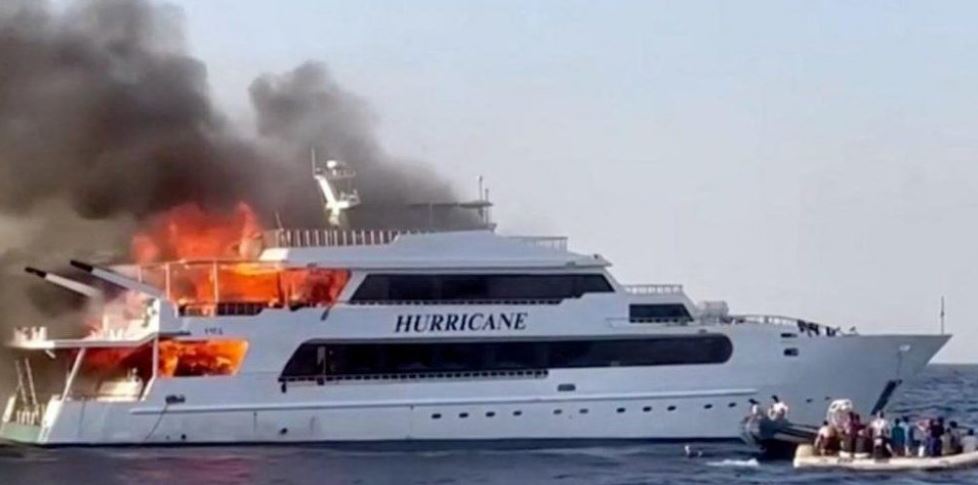
Now why not take a dive on Numidia with me, but be advised this is a long one…..
